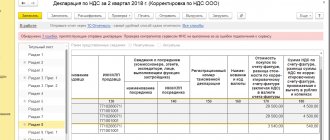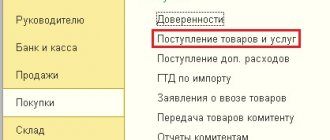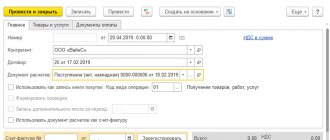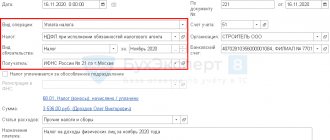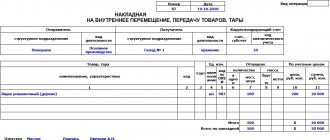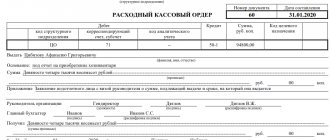The form of the universal transfer document has been changed several times - most recently last year. The document has a column “Product Type Code”, a field for an additional signature, the names of line 8 and column 11 have changed.
The form, rules and example of filling out the UPD are on this page. We will also look at what to write in each field of the document.
Free UPD (in Excel):
Get the form for free!
Register in the online document printing service MoySklad, where you can: completely free of charge:
- Download the form you are interested in in Excel or Word format
- Fill out and print the document online (this is very convenient)
From January 1, 2021, the UPD must indicate the VAT rate of 20%. It must be entered in column 7 “Tax rate” in the tabular part of the document.
You don't know how to fill out the form. Do you need an example of filling out and explaining what to indicate in which field? All this is below.
filling out the UPD:
Get a sample for free!
Register in the online document printing service MoySklad, where you can: completely free of charge:
- Download the form or sample you are interested in in Excel or Word format
- Fill out and print the document online (this is very convenient)
Changes to the UPD from July 1, 2021
The UPD sample has changed since July 1, 2021, following the invoice. Now these documents should have a line to indicate information about the government contract - its number 8. If you don’t know what to write in it, then most likely you won’t have to fill it out. But the line “Identifier of the state contract, agreement (agreement)” itself should be in the UPD in any case.
Read more about filling out line 8 here >>
Changes to the UPD came into force on July 1, 2021. That is, all documents dated this or a later date must contain new details.
Changes in the UPD form from October 1, 2021
Attention!
From October 1, 2021, invoice and UPD forms approved by Government Decree No. 981 dated 08/19/17 are in effect. Here is a list of changes that need to be made to the form:
- column 1a “Product type code”. Here the code of the type of product is indicated according to the unified Commodity Nomenclature of Foreign Economic Activity of the EAEU. Mandatory for goods exported from Russia to the EAEU states: Belarus, Kazakhstan, Armenia, Kyrgyzstan. The code must be selected from the reference book of HS codes (approved by decision of the Council of the Eurasian Economic Commission dated July 16, 2012 No. 54). If you do not have data for this column, put a dash. Applies to invoices, adjustment invoices and UPD.
- field for additional signature. Here the signature of an authorized person is placed, who signs the invoice instead of the entrepreneur. Previously, the form only had fields for the signature of the manager, chief accountant and individual entrepreneur or their representatives.
- name of line 8. Here, from October 1, 2021, it is indicated that the line is filled in only if data is available.
- the name of column 11. From October 1, it is called “Registration number of the customs declaration”. Filled out for goods not made in Russia. We fill it out if the product is not made in Russia.
Download a new sample UPD from 10/01/2017 here >>
More than 1,000,000 companies already print invoices, invoices and other documents in the MyWarehouse service Start using
Does everyone need to indicate a government contract ID in the UPD in 2021?
The state contract identifier in invoices and UPD is needed to make it easier for the tax authorities to control the shipment of goods (work, services) against advance funds received from the federal budget.
If you don't know what to write on the new line, then most likely you won't need to fill it in. Line 8 is filled in only if you are working with a government contract that has been assigned a unique identifier.
If your contract does not have such details, then you do not need to indicate the government contract identifier in the UPD: a dash is placed in the field.
Unique identifiers are assigned to government contracts for defense orders (Article 6.1 of the Federal Law of December 29, 2012 No. 275-FZ “On State Defense Order”), as well as contracts that are financed from budget sources (Article 5 of the Law “On the Federal Budget for 2021”) g and for the planning period 2021 and 2021, Decree of the Government of the Russian Federation dated December 30, 2016 No. 1552).
Beginning of formation
You can use a simplified transfer document from any time. An enterprise is allowed to use both the form recommended by the Federal Tax Service and the one that they create themselves. They are allowed to design their own look as long as it includes all the necessary details.
First of all, it should be brought into line with the format in which the SF is filled out. Then you need to fix the developed template in the accounting policy. And if the existing recommended one does not suit the tax authorities, then it is allowed to completely rework it. The main condition is to ensure the presence and correctness of the details and their location. For example, in the interval of columns 1-11 it is not advisable to change names or delete lines.
UPD is a primary document, the order and sample of which the responsible employee must know. Points to remember:
- who draws up the paper and in what number of copies;
- how the lines are filled in, who should indicate what;
- when should values be entered for certain fields;
- what should be prescribed to the buyer’s representatives and not touched by the sellers.
It is not necessary to warn suppliers, clients and other counterparties; usually they are not against the new system, it does not pose any risks for them if everything is done correctly. But they may find it difficult to fill out the first forms right away. Therefore, we advise you to settle all issues in advance. First make sure they can handle it, and then start shipping the goods using the updated documentation. You can even specify the use of this format in the contract.
There is one caveat - each company affixes a seal at its own discretion, you don’t have to do this. It is only important to decide and form everything the same way.
You can also create all standard shipping documents and UPD through special trading programs. With their help, not only are files printed for signature by the receiving party, but also the entire document flow is organized.
UPD with status 1
Subsection with invoice
Line 1 Document number (in chronological order) and date of its preparation. The maximum period for issuing an invoice is five calendar days from the date of shipment of goods, provision of services, performance of work, transfer of property rights.
Lines 2, 2a and 2b Information about the seller: name, address, tax identification number and checkpoint.
Lines 3 and 4 Information about the shipper and consignee. The lines are filled in only when goods are sold. If the invoice is issued for services or work, a dash is added. If the organization is both a seller and a shipper, then write “aka” in line 3. If the consignee and the buyer are the same person, then indicate the name and address of the consignee (you cannot write “he”).
Line 5 Information about the payment order number. Filled out if there was an advance payment, i.e. in the invoice for the advance payment. If there was no prepayment or it was transferred on the day of shipment, a dash is added.
Lines 6, 6a and 6b Information about the seller. Fill in the same way as information about the buyer.
Line 7 Name and code of currency. An invoice is issued in foreign currency only if prices and calculations under the contract are expressed in it (Clause 7, Article 169 of the Tax Code of the Russian Federation).
Line 8 Government contract ID. Line 8 in the UPD is filled in only if you have the data. If not (that is, if you are not working with a contract, or your contract does not have an identifier), a dash is placed in the line.
Tabular part
A Table row number. You don't have to fill it out.
B Code of goods, works, services. For goods - article number, for work - code according to OKVED, for services - code according to OKUN. The code of goods, works, services in the UPD is given if you need to indicate tax benefits or other special conditions.
Columns 1, 1a and 2 Name of goods or description and units of measurement of work performed, services provided, property rights transferred. Column 1a contains the code of the type of goods according to the unified HS of the EAEU; from October 1, 2021, its completion is mandatory for goods exported from Russia to the EAEU states - to Belarus, Kazakhstan, Armenia or Kyrgyzstan (otherwise a dash is added). The product code is taken from the reference book of HS codes (approved by decision of the Council of the Eurasian Economic Commission dated July 16, 2012 No. 54).
Column 3 Quantitative parameters of goods, works, services. If it is impossible to determine them, a dash is added.
Column 4 Price per unit of measurement (if it is possible to indicate it) without VAT.
Column 5 Cost of the total quantity of goods, work, services, transferred rights without VAT.
Column 6 Excise tax amount. To be completed only when selling excisable goods. Otherwise it is written “Without excise duty”.
Column 7 VAT rate. If the company is exempt under Article 145 of the Tax Code of the Russian Federation or in the case of issuing an invoice by companies that do not work with VAT, it is written “Without VAT”.
Column 8 VAT amount in rubles and kopecks without rounding. In the cases indicated above, it is written “Without VAT”.
Column 9 Cost of the entire quantity of goods (work, services, transferred rights) including VAT.
Columns 10, 10a, 11 Name of the country of origin and its OKSN code, customs declaration number. Filled out for imported goods. Attention! From October 1, 2021, the name of column 11 has changed. It is now called “Registration number of the customs declaration.”
Who signs the UPD? Find out by following the link >>
Official uniform
The form of a universal transfer document, or abbreviated UPD, was developed by tax authorities in 2013 and introduced into circulation by Federal Tax Service letter No. ММВ-20-3/96 dated October 21, 2013 in order to simplify document flow in accounting. And, as far as we know, the department does not plan to change the rules for filling out the UPD in 2021. But despite the fact that the universal transfer document is an officially approved form, organizations have the right to independently make changes and additions to the form.
The peculiarity of the universal transfer document is that it combines the details required for invoices and primary forms, for example, information about the consignor and consignee, details of the payment order, name and address of the buyer, name of the currency, government contract identifier, payer details, name the product and its characteristics, including quantitative, etc. Thus, instead of two transfer documents, one universal one is issued.
IMPORTANT!
Please note: knowing how to correctly draw up the UPD, the sample can be modified to suit the needs of a specific document flow in the accounting department.
When registering for UPD, what is the difference between status 1 and 2?
UPD statuses 1 and 2 determine the purpose of the document. UPD with status 1 can be used both as a primary document for processing business transactions and as an invoice. UPD with status 2 can only be used as a primary document for processing business transactions. Then the invoice is prepared separately.
The status when filling out the UPD is of an informational nature. The actual status of the document will be determined by the details that you specify: for example, if you assigned a document status 2, but at the same time indicated VAT in it, then such a document can be used as an invoice to justify a tax deduction, despite the status.
Types and general rules of use
In practice, the universal transfer document is used in two types:
- with status 1;
- with status 2.
A universal document is filled in with status 1 if it is used simultaneously as:
- invoice;
- primary document.
The universal transfer form of status 2 performs only the function of a primary document. The invoice is issued separately.
UPD is used to document various facts of economic activity. They are listed in Appendix No. 2 to the letter of the Federal Tax Service of Russia dated October 21, 2013 No. MMV-20-3/:
- transfer of results of work performed and services provided;
- shipment of goods;
- transfer of property rights;
- intermediary operations.
The universal transfer form contains the necessary details to reflect information about them. It is used as:
- invoice;
- certificate of services rendered;
- act of acceptance of work results, etc.;
- invoice.
Let's list the basic rules, and then give an example of how to fill out the UPD:
- If you do not need a primary document and need an invoice to receive VAT deductions, do not use the universal deed of transfer (letter of the Federal Tax Service of Russia dated August 22, 2018 No. AS-4-15/).
- Form with status 1 is accepted to obtain VAT deductions and as justification for expenses.
Who signs the UPD?
The universal transfer document must be signed by the responsible persons on the part of the seller and the buyer. For each representative of both parties, you must indicate the position and full name.
More than 1,000,000 companies already print invoices, invoices and other documents in the MyWarehouse service Start using
Signatures in the UPD on the part of the seller:
- In the subsection with the invoice: signatures of the head of the organization (or other authorized person), chief accountant (or other authorized person). If the document is filled out by an individual entrepreneur, then the signature of the individual entrepreneur and indication of the details of the certificate of state registration of the individual entrepreneur. The signature of the authorized person who signs the document instead of the entrepreneur, from October 1, 2021, is placed in the field for an additional signature.
- In the field of table 10: signature of the person who transferred the goods, works, services.
- In table 13: signature of the person responsible for the correct execution of the document. This field is called in the UPD “Responsible for the correct registration of the fact of economic life.” If this employee has already signed the document, then he does not have to sign in field 13 again: it is enough to indicate the position and full name.
Signatures in the UPD on the part of the buyer:
- In table field 15: the person who received the goods, works, services.
- In table field 18: the person responsible for the correct execution of the document. If this employee signed up in field 15, then it is enough to indicate the position and full name.
Electronic UPD: universal format for three types of documents
The opportunity to compile an UPD in electronic form has appeared thanks to the format approved by the Order of the Federal Tax Service dated March 24, 2016 No. ММВ-7-15/ [email protected] The electronic document format is used more widely than the paper UPD. The user himself chooses which details to fill out and which function to select for the electronic document file, which will determine the type of document received:
- SChF - invoice;
- SCHFDOP - universal transfer document;
- DOP - a primary document, for example, an invoice or act.
The document compiler fills in the required details depending on the selected function, because they are different for an invoice and primary documents.
Documents with the functions SCHFDOP (UPD) or DOP (primary document) are signed by both the sender and, as a rule, the recipient. The act for ongoing services is often not signed by the recipient, since the service is considered to be accepted at the time of its provision.
A document with the SSF function (invoice) is signed only by the sender - the seller.
XML structure of the document in the format according to the order of the Federal Tax Service No. 155
XML structure of the document in the format according to the order of the Federal Tax Service No. 820
Electronic documents save your time and resources
I'm switching to EDO
Is it possible to indicate services and goods simultaneously in the UPD in 2021?
Can. Tax legislation of the Russian Federation does not require issuing a separate invoice for each type of product (service). In one invoice (or, accordingly, in one UPD) it is possible to reflect simultaneously the entire shipment (goods, work, services) to one buyer. In this case, you draw up one UPD - instead of a certificate of completion and a delivery note at the same time. It is important to comply with the deadline for issuing invoices - 5 calendar days from the date of shipment).
For issuing one invoice for the entire shipment, see letter of the Federal Tax Service No. ED-4-15/17910 dated September 23, 2016.

